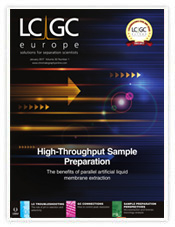|
|
||||||||||||||||||||||
| LCGC Europe Issue Alert Having trouble viewing this email? Click here | ||||||||||||||||||||||
 |
||||||||||||||||||||||
| Web Version | Share with a colleague | View Digital Edition | Subscribe | ||||||||||||||||||||||
|
|
|||||||||||||||||||||
If you would like to submit an article to LCGC, contact Alasdair Matheson, Editor-in-Chief - alasdair.matheson@ubm.com. |
||||||||||||||||||||||
 |
||||||||||||||||||||||
